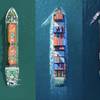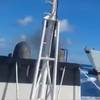CACI International has filed a patent application for monitoring the contents of sealed shipping containers using ultra wideband (UWB) techniques. This marks the first time robust and reliable data signals have successfully been transmitted from inside a sealed container without modifying the container. CACI anticipates employing its application for a wide range of uses, from supporting the movement of military supplies to assuring the security of assets entering the United States.
CACI developed the new monitoring methodology in cooperation with Advanced Resources Corporation (ARC) of Culpeper, Virginia, and Multispectral Solutions, Inc. (MSSI) of Germantown, Maryland. A wireless UWB transmitter is placed inside a container at the time it is sealed. The device senses conditions such as temperature, humidity, pressure, and security breach, and emits data on this via UWB signals from the sealed container. Once the signal is received, processes will be applied to collect and interpret the data, enabling users to identify the container's location, its exposure to temperature and humidity, and whether or not it has been tampered with.
CACI's container tag was tested under the sponsorship of the Navy Automatic Identification Technology Project Office at the Naval Supply Systems Command (NAVSUP). Kevin Fitzpatrick, Assistant Deputy Commander for Fleet Logistics Operations at NAVSUP, said, "This technology opens an entirely new dimension to maintaining asset visibility which overcomes the obstacles that hampered other solution attempts." Applications for the military include logistics support in locations like the Middle East, where difficult transport conditions make it critical to assess the condition of incoming supplies such as ammunition. Within the U.S., the methodology can help secure millions of cargo containers that enter the country each year, enabling agencies like the Customs Service and Coast Guard to monitor container breach and assure that, for example, drugs or explosives are not carried in with otherwise legitimate cargo. In the case of hazardous materials, the transmitters can alert users to leakage or damage before dangerous toxicity levels are reached, and without risking the lives of those who might otherwise have to physically inspect the potential threat.
Sponsored Content
Protect Your Crew. Exceed Weld Standards.

MSC Sets a New Standard for Time Off in 2025, Plus Earn a $44,345 Bonus as an Able Seaman!

August 2025
 Read the Magazine
Read the Magazine

 Read the Magazine
Read the Magazine
This issue sponsored by:

Washington Watch – Water Carrier Statutes & Regulations
Subscribe for
Maritime Reporter E-News
Maritime Reporter E-News is the maritime industry's largest circulation and most authoritative ENews Service, delivered to your Email five times per week








